It was a shot I would have likely passed on 20 years ago. On the very last afternoon of our special doe season here in the Texas hill country, the deer were at a steep angle on the opposite side of a field below me, and they were wary.
The wind was in my favor, and even though they seemed a good ways away, by the time I saw them, they were already looking right at me. Four months of heavy hunting pressure had put them on high alert.
I set down the Hog Saddle tripod quickly and mounted my SCAR 20S as quietly as I could, only to look through the scope and see nothing. They were already trotting away into the safety of cover. But a couple of does didn’t leave with quite the alarm as their sisters.
The Leupold RX-2800 TBR/W rangefinder told me the deer were only 255 yards away and they were quartering. 1.1 mils of elevation and .6 mils of wind. Even with the deer at a slow walk, that’s not a challenging shot for any competent marksman.
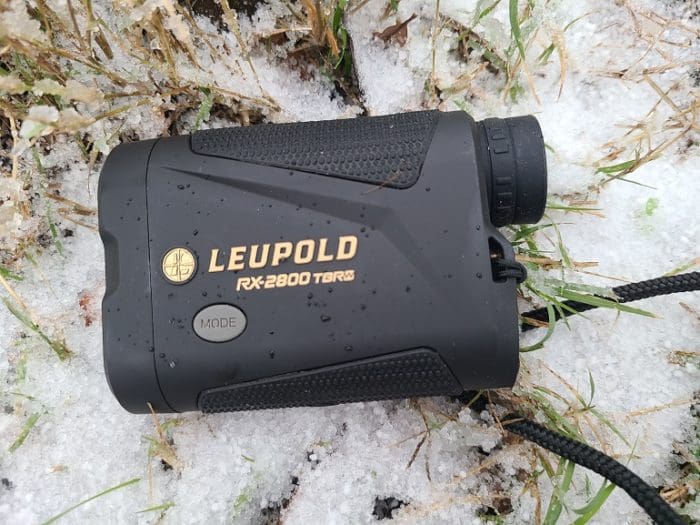
I likely would have passed on that shot a couple of decades ago, partly because it was a 21 degree angle. I would have guessed less than that and I would have known I was guessing. I also would be guessing a bit on the distance as the deer were walking, and using the crosshairs to range a walking target takes time. I didn’t have much time before they reached the cover.
But I wasn’t guessing. In fact, I knew exactly how far away they were, down to the yard and the exact angle. I knew the line of sight distance, as well as the only important number, the equivalent horizontal range. With that number and a quick glance at the ballistic software on my phone, all I had to do was dial, hold still, and squeeze. The tools did the rest. One round later, a fine freezer trophy lay waiting for pickup.
There’s probably been no tool that’s changed shooting and hunting like the compact digital laser rangefinder. Are you carrying a rifle chambered in a particular caliber because it’s “flat shooting?” Why? Flat shooting doesn’t matter anymore.
With a tool like the Leupold TX-2800 and ballistic software, knowing your precise distance is no longer an issue. Loading or shooting a cartridge for a flat trajectory just doesn’t make sense. Terminal performance and wind are the concerns now, and wind is the only unknown variable of concern.
Beyond hunting applications, compact digital rangefinders have changed the entire competitive landscape. The silhouette shooting I did as a young man (still a valuable skill set) is radically different than the long range shooting sports today. The competitions I’ve entered, with the exception of the Hundo in Hondo, are driven mostly by the quality and complexity of laser range finders, extremely high quality scopes, and the shooter’s ability to identify and characterize targets with that gear. The rifle is secondary.
Then, of course, there’s Extreme Long Range, in which shooting distances of two miles and more is common. This is a sport that simply wouldn’t exist without laser rangefinders and a whole lot more gear on top of that.
The way a laser range finder works is pretty simple in principle. It sends a series of infrared pulses that then get reflected off the target and sent back to the device. The device then calculates the time it took for those bits of the invisible EM spectrum waves to return. Science FTW!
Of course, that means the target has to reflect the energy back, and that’s where things get a little tricky. Your target has to be large enough and reflective enough to get the signal back to read and calculate. Reflectivity is the key here, and it makes for a pretty big difference in how far out you can get a reading on a target.
The Leupold website states that the RX-2800 provides “½ yard accuracy out to 2,800 yards.” That’s impressive.
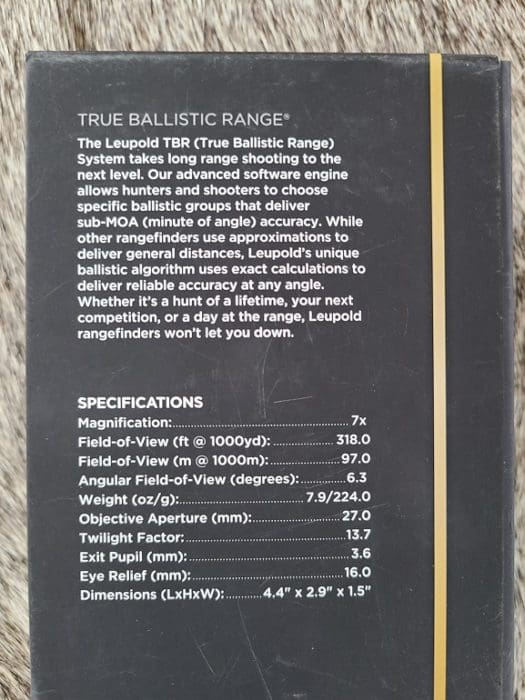
The Leupold RX-2800 TBR/W will provide you data on reflective targets, (think white painted steel targets on a range) out to 2,800 yards, trees out to 1,300 yards, and deer out to 1,100 yards. I’ve had this rangefinder all hunting season and, thankfully, I had a few more conditions to test it under than I normally would have.
The freak snowfall here in the Texas Hill Country earlier this month gave me a bit of an opportunity. (In case anyone cares, the last time we got this much snow on the ground was 1936.) That’s right, weathering the onslaught of mild winds and barely freezing weather, I braved the accumulated white death for you, dear reader.
Standing in front of one known survey post and targeting a red metal sign attached to a post 1,466 yards away, the Leupold RX-2800 gave me the line of sight reading of…1,466 yards. Dead on.
I also got to test it heavily in the field. I never found any reflective targets at 2,800 yards, but I found metal home and barn roofs at 2,000-2,200, and it read those just fine. It also nailed deer at the 800-900 yard range. I couldn’t get it to lock on to a bobcat at 460 yards, likely because it was just too small a target, but I could very quickly get the range of the rocks in the dirt road he was standing in.
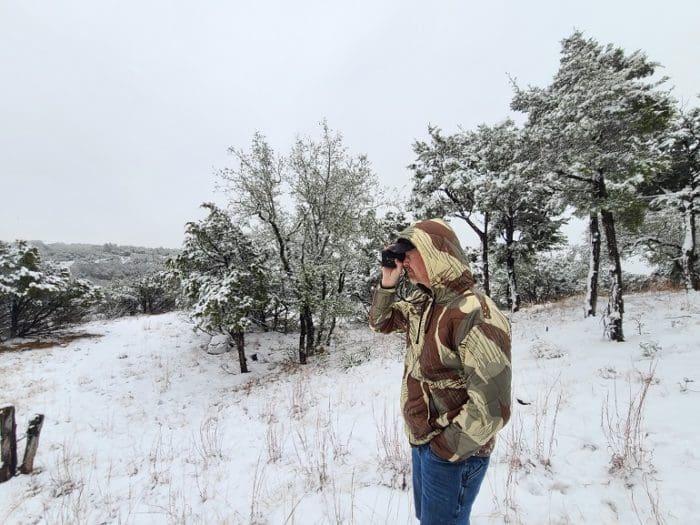
I’ve used the Leupold RX-2800 heavily over the last five months and have yet to have any issue with it. That snow? I set the rangefinder on the ground in it, without the case, and left it there for two days. By that time, it had stopped snowing and started doing what we are far more familiar with…sleeting with freezing rain. I wiped it off. No issues.
I also just put it in the sink for a few hours, submerged in cold water. Unsurprisingly, no issues. I haven’t intentionally tried to destroy it, but I have dropped it a few times, intentionally and not so intentionally. So far, nothing has phased it. Leupold electronics don’t get quite the same warranty as some of their optics, but this one includes two years from the time of purchase.
These compact digital laser rangefinders have come a long way. It’s been a few years now since just being accurate and durable was good enough. Leupold has tried to put as much as possible into this rangefinder with some great features and some of questionable value.
Simple line of sight distance has value, but if you don’t know the angle of your shot you’ll still need to do some math. (When in doubt, hold low.) That’s why almost all of the newer rangefinders also measure the angle for you and do the trigonometry to determine what the equivalent horizontal distance is. This is called “TBR” mode for the Leupold rangefinders, which stands for “True Ballistic Range.” When hunting, TBR Basic is likely the only function you’ll be using.
Using TBR Basic mode and the simplest reticle, (you get to choose from three different reticles) the display provides the user with tons of space to view the target, a tidy aiming point, and all of the information you need to take your shot right below the reticle. It’s exactly the display I want for a hunt.
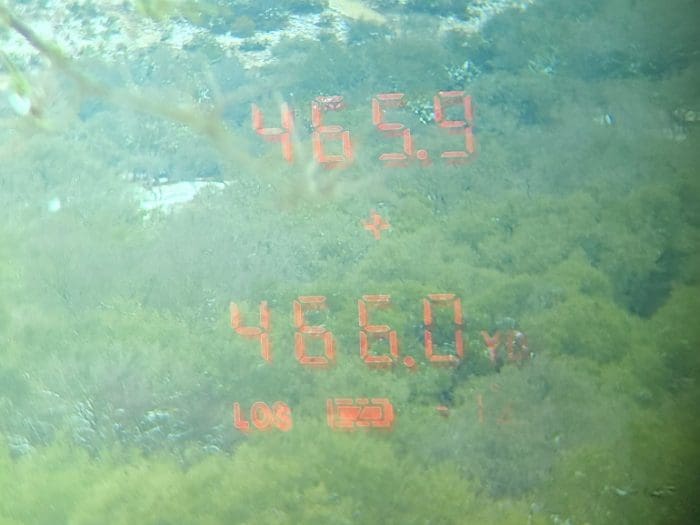
There are, however, several modes of operation. You can use the Line of Sight mode, which will give you the meters or yards without angle correction. The only other mode I find valuable is the TRIG mode, which gives you both the line of sight and equivalent horizontal distances as well as the angle. That’s probably not what I’d use hunting, as it’s more information than I need and clutters the screen, but it’s valuable for some competitions, range days, and for setting up your range.
There’s also a MIL and MOA mode, which will provide the shooter with a holdover value, depending on the “Load Group” of the cartridge. There’s been a lot of work put in here by Leupold, and this is also where I see relatively little value for most shooters and hunters.
Inside the RX-2800 exists a couple of pages of calibers, zero ranges, grain weights, and muzzle velocities. On Leupold’s website there’s a lot more. These represent their “Load Groups.” For instance, a 6.5 Creedmoor shooting a 140gr Hornady A-Max bullet at 2,710fps with a 200 yard zero falls into Load Group 10. A .30-06 Springfield round shooting a 180gr Nosler Accubond bullet at 2,700fps with a 300 yard zero fall into Load Group 24.
If you can find match up all these values with what you are shooting, or load your preferred cartridge to match one of those recipes, then the RX-2800 TBR/W will provide you not only with the Line of Sight Distance, but also your elevation adjustment in mils or MOA.
There’s also the wind feature. Assuming a 10mph full value wind, the RX-2800 TBR/W will give you your wind hold, in mils or MOA. The wind speed is not adjustable, and the values are only accurate out to 600 yards.
These features are interesting, but of little value, as they are simply too rigid. There’s no adjustment for atmospherics, and I can’t find what atmospherics those holdover values are set at from Leupold. Also, the load group data seems to fit factory loads, and the muzzle velocities are at the top of the charts in my reloading manuals.
For most of the calibers I hunt with, I am simply unable to reach the velocity listed by Leupold. If you are able to match your zero distance, caliber, bullet, muzzle velocity, and the wind is 10mph at 90 degrees, then the RX-2800 TBR/W is going to give you reasonably accurate elevation and wind holdovers out to 600 yards. Good luck and hope that this recipe shoots well in our rifle.
Where I do see some value is for the military shooter, or anyone who is going to shoot a specific load from a rifle for every engagement, and not too far away. For those cases, the load may very well perfectly match one of the Load Groups, and the atmospherics may be close enough to get reliable hits on the expected target size and distance.
The scan feature is great, and functions perfectly. Hold down the button and simply pan slowly. The RX-2800 will give you constant readings. That’s very helpful for teeny tiny targets, or for creating a sector sketch. You can use the 7X zoom to scan your whole area, doodle what it looks like, and mark down distances of rocks, fence posts, trees, etc, for fast reference.
When game shows up, you’ll have your adjustments all written down for fast reference and easy shooting, assuming you brought some type of ballistic application with you.
That 7X zoom, combined with a sharp image is also particularly valuable. Glass clarity and resolution really suffer on some compact rangefinder, but not the RX-2800. On a recent hunt near the Texas/Mexico border, it was very easy to identify the deer I could shoot (5 1/2 years and less than 150″) and the deer I couldn’t shoot (anything else), all the way to just over 600 yards.
Antler spread, neck size, face shape, belly and back shape, and other details were readily visible. The same was true of the bobcat sneaking about 200 yards away. I could watch it through the rangefinder, pressing the activation button, and read out the yards as he steadily crept. With the image clarity, zoom size, and pan function, I never had to let go of the power/activate button and never had to look away from the target.
The RX-2800 TBR/W is powered by a single CR-123, one of which is included. The rangefinder is only on when the button is pushed, so battery life is pretty substantial. I’ve used it quite a bit over the last months, and I haven’t changed out the battery the rangefinder came with yet.
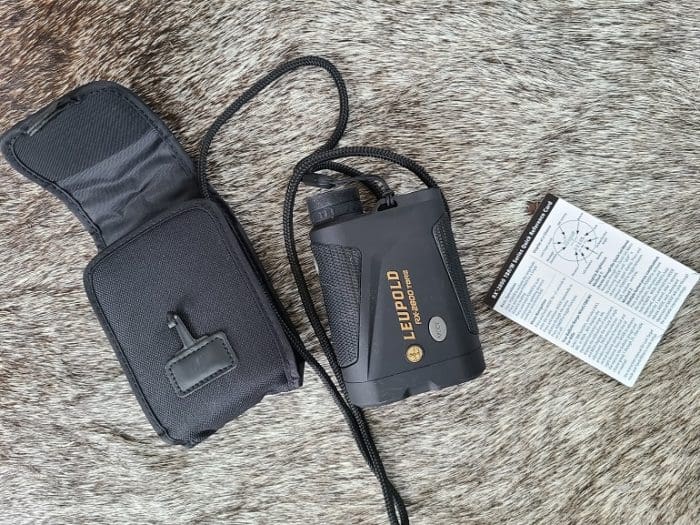
Compact digital rangefinders have changed the game for hunting and shooting, and multiple companies have gotten in on that game. Pretty much all of the major optic manufacturers offer something in this group. Leupold’s RX-2800 TBR/W cuts its way through the noise of that crowd, not by the holdover and wind functions, but by providing fast, precise measurements under a wide range of conditions.
As usual with Leupold, it’s the image quality, especially in low light, that really stands apart from the other companies’ entries. All of the other bells and whistles are important or nice to have, but seeing the target and getting an accurate measurement is really what it’s all about, and the RX-2800 TBR/W absolutely excels at this.
Specifications: Leupold RX-2800 TBR/W Laser Rangefinder
Finish: Black/Black Armor Finish
Linear FOV: (ft/1000 yd) Low 318
Weight: 7.9 oz
Linear FOV: High 318 (ft/1000 yd)
Length: 4.3 in.
Max Range: Reflective 2800 yds.
Max Range: Trees (yd) 2400 yds.
Max Range: Deer (yd) 1800 yds.
Precision: 18″ in 2,800 yards
MSRP: $779.99 (about $530 retail)
Ratings (out of five stars):
Overall * * * * *
I have several other rangefinders from several different companies. This isn’t just the one I used this hunting season because I wanted to review it. I reviewed it, and then kept using it because it was the best of the bunch. I don’t see that changing anytime soon. The holdover functions work fine, but I have no use for them. The real selling point for me on the Leupold RX-2800 TBR/W is the image quality in real hunting conditions, the proven ruggedness of the device, and how fast and precisely it can pick up on a wide range of targets.

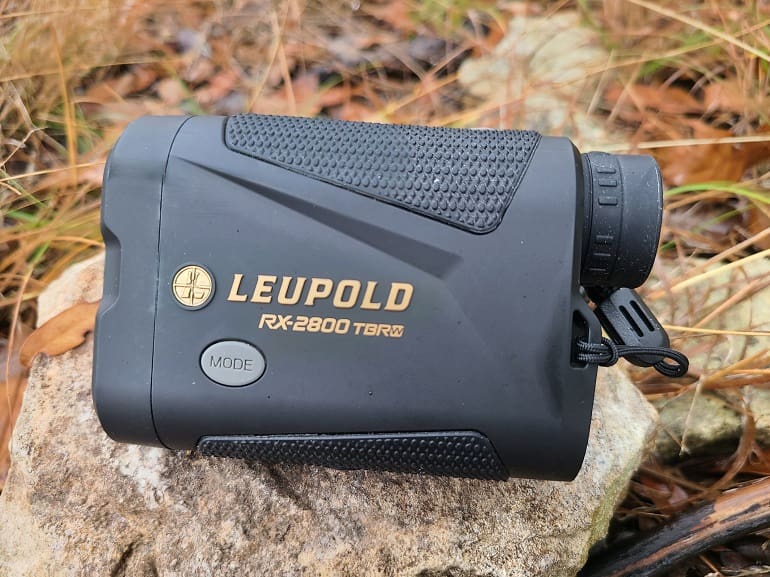



Afternoon JWT,
You appear to be recovering well.
Snow!? Send it up here. Tried to go sledding at my favorite backcountry area over the weekend and there was only a couple of feet of crusty, frozen crap. The ice skritchers got a workout.
As usual, you’re thorough in your evals…covering just about every base.
…however…
I’m a little confused regarding the magnification power…is it a fixed 7X or a variable 7X (zoom).
Recovering well. Hard to keep my BP under 120 systolic, where they want it to be, but otherwise great.
The magnification is a fixed 7X.
Quality reviews are appreciated…keep ’em coming.
I would love an unassisted systolic of 120 or less.
Thanks for the clarification on the magnification factor.
I also have a Leupold rangefinder. I’m about as happy with mine as you are.
I think most people would be much better served by using this, plus known dope, than by mentally wrestling with calculating distance on a FFP scope’s reticle subtensions. Plus saving a fair chunk of money across all their rifles.
Like knowing their pace count and how to use a compass, I wish every shooter understood how to fully use a reticle to precisely range targets. I’d love for them to practice it every once in awhile. I’d love for them to memorize the formulas, or at least keep them on a card with them.
And then just use a rangefinder.
Mr. Taylor,
I always encourage people to learn “old school” methods for the simple fact that modern technology is far more failure prone than simple “old school” methods.
Not only does modern technology rely on batteries, it also relies on evermore sophisticated electronics and software which are becoming increasingly delicate and failure prone. And then you have the fact that many modern technology platforms rely on cellular networks and/or Internet-based platforms which are increasingly vulnerable to failures in their own right, not to mention intentional disruptions thanks to “cancel culture”.
I’m with you on learning the non-electronic ways, but the reality is, we need them less and less. Our electronic devices may be more sophisticated, but they are more robust than ever. Drop either this rangefinder or your DOPE card from a tree stand, and nothing happens to either. Now drop both of them in the snow, or worse, in a creek or pond, and only the electronic rangefinder comes out useful.
Neither the ballistic software, nor the rangefinders, require an internet or mobile connection. If the ones I used did, they’d never be of use, as there is little to no connectivity on our ranch away from the main house. And batteries are easier to find than ammo.
Mr. Taylor,
Are you sure about that? Of course the rangefinder is a stand-alone device. What you most likely do require of the Internet, though, are the ballistic details of your ammunition that you are using to determine which “load group” your ammunition falls into (if you want to use the advanced features of that range finder). At most your box of factory ammunition shows you a table of velocity at the muzzle and every 100 yards out to 400 yards. What it most likely does not show you is the your bullet’s ballistic coefficient which you need for those advanced calculations.
Speaking of those advanced calculations and ballistic calculators, do you already have a hard copy of a ballistic calculator software on your own flash-drive that you can access without the Internet to make your manual DOPE card? And for you hand loaders out there, do you have hard copy (e.g. paper book) loading manuals with all the relevant details? Or do you rely on online loading resources to determine your loads and projected muzzle velocities?
I am not trying to give you grief or be a curmudgeon. I am simply trying to make people aware just how much we have come to rely on the Internet (including cellular access) and how easily that can be “cancelled” in our current state of affairs.
I don’t know about all of them, but most of the ballistic aps I use have a robust bullet library built into them that does not require the internet to be used. But even if you did need the internet to find the original data, you would then just save it in the ap, without the need to continue to go to the web after that. It’s the same information you would need a book to find, just more accurate and inclusive.
No matter of it came from the internet or a book (which the authors used the internet to write, research, and deliver) you still need to save the data in both digital and hard copy, if it’s important.
ALWAYS THANKS FOR INFOR
Range of 2,800 (1.59 miles!) yards is impressive — even if it requires a “reflective” surface.
If I were inclined to engage in long-range shooting, I would probably buy one of these.
I have an inexpensive range finder that I use almost exclusively for ranging shots on level ground out to 40 yards (for handgun and archery hunting) and out to 125 yards (for white-tailed deer hunting with shotguns, muzzleloaders, and rifles chambered in the .44 Magnum handgun cartridge).
I have yet to hunt a location where I could have a shot beyond 300 yards. When I hunt those areas, I use a serious rifle caliber (such as .270 Winchester) whose ballistics do not require ranging — assuming that I zero my scope/rifle to 200 yards.
With a factory 130gr load and a 24″ barrel, if you’ve zeroed at 200 yards, and you see a deer at 300 yards, you’ll need to hold 6 1/2″ high. Don’t account for that, and you’ve missed the heart and probably just clipped the bottom portion of the lungs of a white tail deer. Now you’ve got a chase on your hands. Of course, the real question is, “is that 300 yards, or 350?” Depending on the angle, and how much time you have to shoot, that can be difficult to determine. And if you zero at 200 and don’t get that right, you’ve shot 12″ low, and right under your game.
All excellent points.
While I have enough experience/skill to determine that a white-tailed deer is well beyond 200 yards which requires aiming a bit high, I will readily admit that I probably cannot determine the difference between 300 and 350 yards which probably leads to a wounded deer and a long chase. (I despise such situations and regard them as unethical.) That definitely argues strongly even for a simple rangefinder.
Important note: when I have time in advance of hunting, I will manually “range” (e.g. pace) distance to prominent landscape features ahead of time so that I know “critical” distances before hunting. Those critical ranges would be either:
1) when bullet velocity is too low for ethical kill shots
2) when I have to start aiming high
Bullet velocity (too low) comes into play with shotguns, muzzleloaders, and handguns — and can be as close as 50 yards. Aiming high comes into plain when a game animal is well past my scope’s “zero” distance.
All solid points. People hunt differently, and in very different places. I love pistol hunting and my flintlocks are my favorite.
But most of my deer, dozens each year, are taken past 300 yards, and many in that field just to the left of the 465.9 range mark in the photo in the article above. The front of that field is 400 yards from the back porch, the back of it 500. The deer are usually in between.
That’s awesome, thanks dear for Rangefinder.
“หวย อันดับ 1 มาแรงแซงทุกเว็บ
เว็บพนันออนไลน์ เว็บตรง ไม่ผ่านเอเย่นต์ฝาก-ถอน รวดเร็ว ด้วยทีมงานคุณภาพ ตลอด 24 ชั่วโมง มีความยุติธรรมและโปร่งใส ไม่เคยมีประวัติการโกงลูกค้า”
หวย อันดับ 1 มาแรงแซงทุกเว็บ
เว็บพนันออนไลน์ เว็บตรง ไม่ผ่านเอเย่นต์ฝาก-ถอน รวดเร็ว ด้วยทีมงานคุณภาพ ตลอด 24 ชั่วโมง มีความยุติธรรมและโปร่งใส ไม่เคยมีประวัติการโกงลูกค้า
“HUAYDED789 หวยออนไลน์ 24 ชั่วโมง ระบบที่ทันสมัย แทงหวยง่าย โอนเงินไว หวยออนไลน์ที่นี่จ่ายสูง ส่วนลดเยอะ โปรโมชั่นพิเศษสำหรับสมาชิกใหม่ และสิทธิพิเศษมาก มาย แจกเครดิตฟรีอย่างต่อเนื่อง”
Comments are closed.